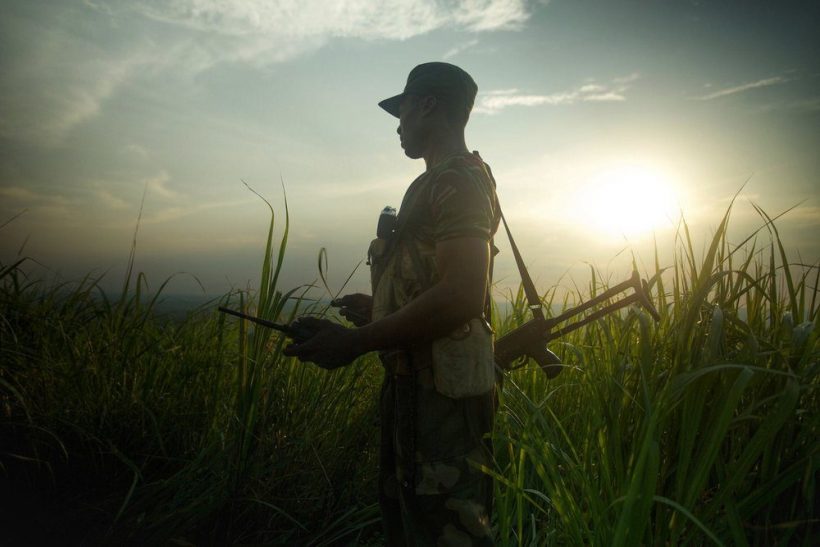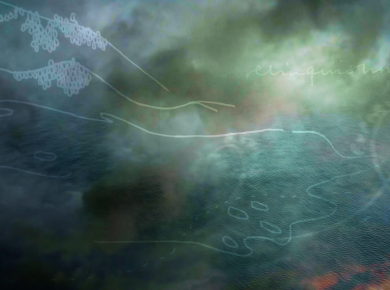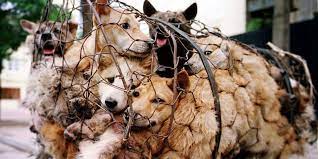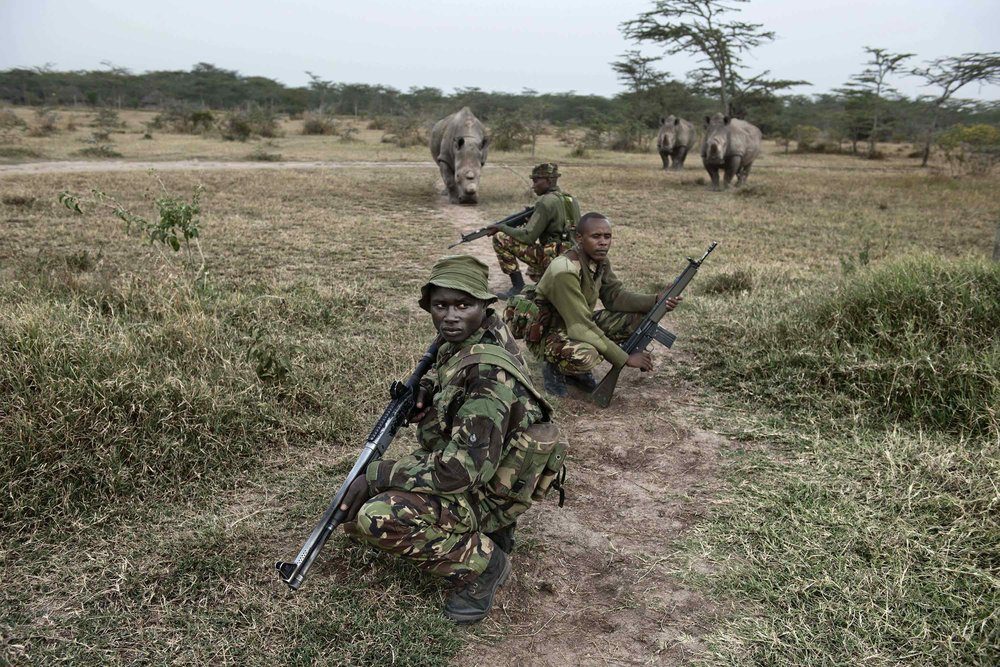
There are only three Northern White rhinos left in the world, all of whom live at Ol Pejeta Conservancy in Kenya where they are heavily protected. Photograph: Kate Brooks. Portrait photo of Kate Brooks, filming over Garamba National Park in Democratic Republic of Congo by The Last Animals.
The Last Animals is a documentary film about the extraordinary people fighting poachers and criminal networks to protect the world’s plummeting populations of elephants and rhinos. The producer, writer and director is Kate Brooks, an award-winning photographer who has chronicled conflict and human rights issues for nearly 20 years: from early work documenting child abuse in Russian state orphanages to following the effects of 9/11 across the Middle East and in Pakistan and Afghanistan.
The Last Animals is many things. It is a tribute to the efforts – often at great risk to their own lives – of conservationists, park rangers and activists to bring the world’s most majestic creatures back from the brink of extinction. It is a profile of the tragic network of influences – from the illegal wildlife trade to international terrorism and border security – that makes this so hard. Finally, it is a call-to-action, a plea, on behalf of the animals themselves, born from Brooks’ belief that, for many species such as the Northern White Rhinoceros, extinction may be imminent. At the age of 45, Sudan, the last male is extremely ill.
In this interview, Brooks talks about her inspiration for the film and what she hopes audiences will take away from seeing it. Because, as she says, “if we don’t care for our planet and the other species on it”, the ‘last animals’ will not be the elephants and rhinos – the grand, intelligent, loving creatures that are currently being gunned down across the plains – but humans themselves: authors of our own destruction.
HN: What inspired you to make The Last Animals?
In 2010, after embedding as a photographer, with a Medivac unit at Kandahar Airfield in Afghanistan, I went to Kenya on a long planned vacation. It was in the Maasai Mara that I was able to heal from some of the inhumanity I had witnessed: countless troops and Afghan civilians having their limbs blown off by IEDs and Afghan children being erroneously bombed as terrorists by coalition forces.
Seeing a herd of elephants cross my eye line for the first time across the plains reminded me that, in spite of all the human destruction on the planet, there is still some natural order on it – which ultimately inspired me to want to do something. When I heard that over 80 elephants had been gunned down on the border of Chad and Cameroon in a single incident, I felt that I had no choice but to pick up my cameras.

According to the Great Elephant Survey, there are less than 800 elephants left in the country of Chad. The elephant population in Zakouma National Park in Chad plummeted from approximately 4,000 in 2005 to just 450 in 2010 due to massive poaching. After an intensive anti-poaching program was implemented, elephant numbers stabilized and calves are being born again. Photograph: Kate Brooks.
HN: Your focus is on the people around the animals: the conservationists, scientists and activists battling poachers. Describe the conditions they face.
The heart of the film is about the human sacrifice being made to protect the remaining elephants and rhinos on the planet. In Garamba National Park in the Democratic Republic of Congo, rangers risk their lives on a daily basis and the scientist and investigators bringing the criminal groups behind the trade to justice also run the risk of retribution.
HN: Are there people who have stuck in your mind?
Every person featured in The Last Animals is a hero to me, and there were countless others who were interviewed for the film whose commitment and passion inspire me. There is a global network of people who dedicate their lives to saving elephants, rhinos and other endangered species. They wake up each morning, doing their part to make a difference for the voiceless.
HN: As a documentary maker specialising in conflict, how do you manage feelings of anger and empathy?
While I document the darkest sides of humanity, I also get to see humanity at its best, counteracting those forces. Inevitably, that creates some kind of balance, but it can also be hard at times.
HN: What do you want people to take away from The Last Animals?
If we don’t care for our planet and the other species on it, human beings will be the last animals. When people see the film, they understand on a visceral level that not only is the illegal wildlife trade leading to extinction, it’s also fuelling conflict and criminality and leading to the destitution of families and communities in Africa.
HN: What actions need to be taken to save the wildlife?
Traditionally, the illegal wildlife trade has been a low risk, high reward, illicit trade. Part of the reason it spun out of control was because there hasn’t been a strong enough legal framework to protect wildlife and prosecute the criminal networks exploiting legal loopholes and weak penalties. That’s started to change but there is still a long way to go.
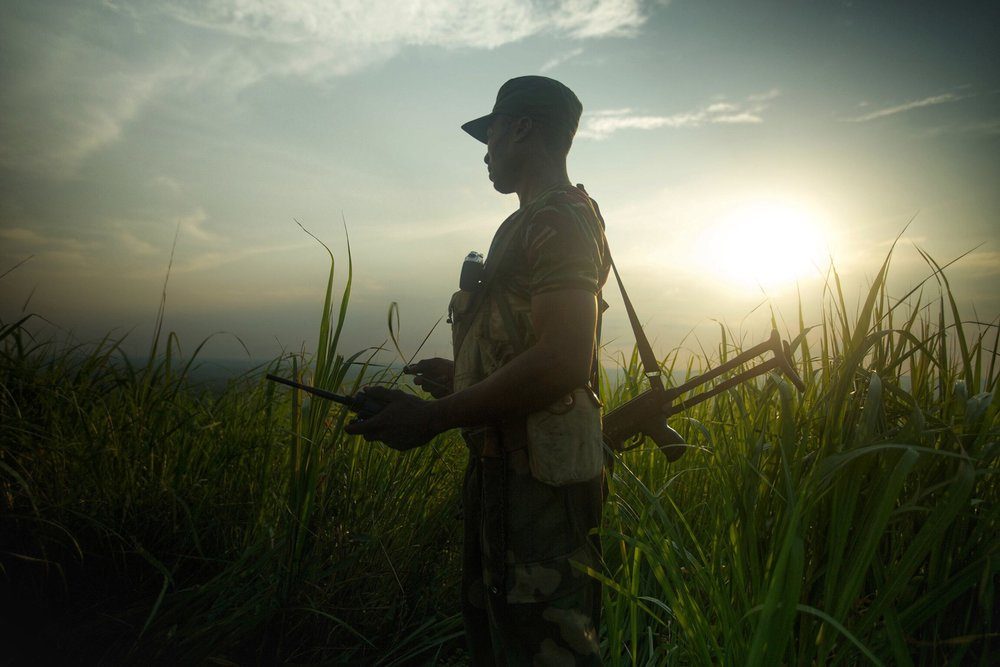
A ranger looks out over Garamba National Park at daybreak. In 1977 there were 22,000 elephants there. Today there are about 1,200. Garamba is the second oldest national park in Africa and one of the deadliest for both elephants and rangers. The Lord’s Resistance Army and Sudanese rebels are both active in the park. Photograph: The Last Animals.
HN: What gives you hope?
Laws are changing. Over the past five years, Kenya has strengthened her wildlife trafficking legislation. The law and penalties are now real deterrents. Additionally, there are NGO monitors in courtrooms observing wildlife trafficking cases to ensure that justice is served and the law is abided by. The US passed a “near total ban” on the ivory trade, 44 states have passed state legislation on ivory and the trafficking of other endangered species. China passed an ivory ban and so has Hong Kong. There is a global movement happening. As each domino falls, the next can be the point of focus.
There is also the recognition that attempts to maintain legal markets have failed worldwide and the trade must come to a full end because legal markets are providing cover to launder smuggled ivory and it’s making it harder for law enforcement to uphold the law.
HN: If there was one thing the ordinary person could do to help, what would that be?
In terms of wildlife trafficking, and the protection of animals on the planet, I would say: become educated on the laws in your country, lobby for stricter legislation and support international petitions. An ivory ban in the UK is currently pending. The EU is also now reviewing its wildlife trafficking and ivory trade laws. It’s absolutely critical that the public engages with these issues and takes a vested interest. Without a fully comprehensive legal framework, these animals have no chance at a future.
UPCOMING SCREENINGS
March 8, 2018: Women of the World Film Fair Middle East, Dubai, UAE http://wowmiddleeast.com
March 7,9, 11, 2018: One World: International Human Rights Documentary Film Festival, Prague, Czech Republic www.oneworld.cz
March 15, 2018: National Geographic, Environmental Film Festival in the Nation’s Capital, Washington DC https://dceff.org
March 23, 2018: Sebastopol Documentary Film Festival, Rialto 7, Sebastopol, California https://sebastopolfilmfestival.org
March 27, 2018: Frontline Club, 13 Norfolk Place, London W2 www.thefrontlineclub.com
April 23, 2018: Regents Street Cinema, London www.regentstreetcinema.com
